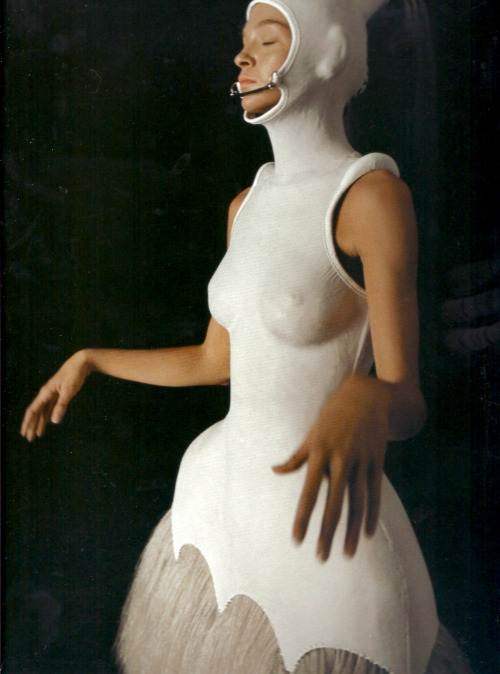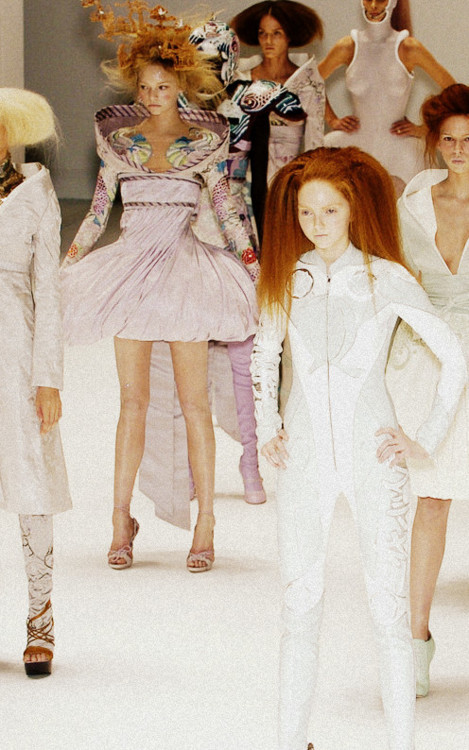For his S/S 2005 collection ‘It’s Only A Game’
(which can be seen in full here), McQueen offered up a collection which is
better described as a personal greatest hits than as a stand-alone collection. Although
he had always been self-referential (it is always said that the only way to
truly become iconic is to repeat imagery), this collection saw him re-interpret
a series of his staples by adding a new, feminine touch. It is an example of
McQueen’s new, lighter aesthetic which appeared to come after the business was
acquired by the Gucci group and, tellingly, after his time working at Givenchy.
The setting for the show eventually revealed
itself to be a giant illuminated chessboard – a set choice which seems to
represent the brutal nature of the fashion industry in which designers are
targeted and replaced by new, younger models. Upon this chessboard stood 36
models, each of whom wore outfits which sometimes correlated with one another
and sometimes bore no relation whatsoever, eliminating the notion of any kind
of definitive ‘aesthetic’ for the season. A few of the opening looks created
the image of a horny Edwardian schoolgirl, with flared frilly skirts and
semi-sheer blouses – a contrast against the nautical looks which followed them
which showed navy sailor jackets and tailored trousers injected with a few
signature McQueen touches.
Seemingly sensing an overdose of romance, the
designer sent out the first re-interpretation of his Yoruba-inspired ‘Eshu’ collection.
The first of three looks, the model stomped down the runway with a moulded
white dress which created a plaster-cast rendering of the female anatomy, one
which was accessorised with a hemline adorned with horse hair and a
brutal-looking metal mouthpiece. Fittingly, this is the one dress amongst the
three that made its way into the incredible ‘Savage Beauty’ exhibition, showing
that the designer has the ability to edit and improve upon his own aesthetic.
As for the other two looks, both featured the moulded breast corset but both
were softened by the addition of colourful tribal prints on the lower half, adding
a delicacy to the overall look. Other highlights of the show saw Gemma Ward
modelling a lilac dress complete with a puffball skirt and an elaborate gold
headpiece, whereas another look was a colourful take on American sportswear
which was combined with a lilac obi sash, purple thigh-high boots and a helmet.
Overall, the show was a huge success in the
sense that it tied together all of the greatest and most recognisable aspects
of McQueen’s aesthetic and presented them in an impressive and original
fashion. By this point it had become clear that the most recent incarnation of
the designer (from 2002 onwards) was interested in challenging himself to break
free from the designer that he had been labelled as, namely one which revelled
in using grotesque imagery to shock and challenging the notions of beauty. To
simply label McQueen as a ‘showman’ seems unfair considering the amount of
craftsmanship which went into his clothing, so this show seemed to be an
example of the designer bringing his past into the spotlight and making some of
his older collections more accessible to a wide audience. The collection
spawned some of McQueen’s most feminine pieces and made people acknowledge his
iconic back catalogue - a move which established him as one of fashion’s true
icons.





No comments:
Post a Comment